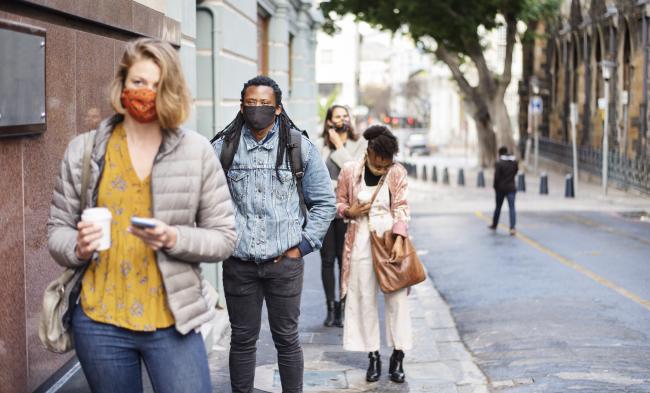Study examines measures to slow COVID-19 spread
February 2, 2021
Study examines measures to slow COVID-19 spread
At a Glance
- Modeling of SARS-CoV-2 spread in Hunan, China showed that a minority of people infected with COVID-19 transmitted most infections.
- More than half of infections were spread before infected people developed symptoms.
- The findings could help inform better policies to control the spread of COVID-19 while balancing economic impact.

Countries around the world have tried a combination of approaches to slow the spread of COVID-19. Some strategies focus on isolating people who have the virus and identifying their close contacts. Other approaches affect the entire population, like mask-wearing, social distancing, and stay-at-home orders. Because multiple strategies are usually in effect, it has been hard to determine the impact of each.
To better control the pandemic, it’s critical to understand the factors driving its spread. A team of researchers, led by Drs. Kaiyuan Sun and Cecile Viboud of NIH’s Fogarty International Center (FIC) and Dr. Hongjie Yu of Fudan University (Shanghai, China), studied the transmission of SARS-CoV-2 in China’s Hunan province. Their findings were published on January 15, 2021, in Science.
Hunan was among the first regions in the world to have a SARS-COV-2 outbreak. They quickly brought their outbreak under control using several approaches. Strict lockdown measures restricted people from leaving their houses except for essential tasks. People were required to wear masks and maintain physical distance when in public.
Those who were infected were treated in dedicated hospitals. Careful contact tracing identified anyone who might have been exposed. These contacts were quarantined in medical observation facilities.
The researchers examined detailed records from 1,178 COVID-19 patients. The cases occurred between January and April 2020. They also looked at data on more than 15,000 of their close contacts.
Using the contact tracing records, the research team developed a series of models to study COVID-19 transmission in Hunan. The models revealed that a minority of people infected with SARS-CoV-2 were responsible for transmitting most cases. About 80% of cases were spread by 15% of infected individuals. Similar to other studies, the researchers found that the risk of infection was higher with longer exposure. Close social interaction also increased transmission risk.
Members of the same family posed the highest risk of infection. Lockdown measures, while decreasing transmission from other sources, increased the likelihood of infection within a household. The risk of infection, per contact, was lowest in the community—riding public transit and visiting food and entertainment venues. The researchers could not evaluate transmission risk in schools or workplaces, however, because of lack of data.
In line with other reports, the team found that people with COVID-19 were most infectious in the period just before they developed symptoms. The analysis showed that 53% of transmission in Hunan occurred during the presymptomatic phase of infection.
The researchers used these results to evaluate different interventions. They found that Hunan was able to slow transmission by quickly isolating COVID-19 cases and quarantining contacts. However, they determined that controlling the epidemic solely with isolation and quarantine is not feasible. Community-wide measures like mask-wearing, increased telework, and restrictions on large gatherings must also be put in place to control spread.
The authors also note that the capacity for testing and contact tracing are crucial for maintaining control over infection rates when easing lockdowns.
“Our findings give insight into the biology and behavior that drive COVID-19 spread,” Sun says. “We hope that this evidence helps to guide the design of targeted and sustainable strategies to control SARS-CoV-2 transmission.”
—by Erin Bryant
Related Links
- Lasting Immunity Found after Recovery from COVID-19
- Experimental Coronavirus Vaccine Highly Effective
- Antibodies and T Cells Protect Against SARS-CoV-2
- Computer-Designed Proteins May Protect Against Coronavirus
- Immune Cells for Common Cold May Recognize SARS-CoV-2
- Potent Neutralizing Antibodies Target New Regions of Coronavirus Spike
- Potent Antibodies Found in People Recovered from COVID-19
- Llama Antibody Engineered to Block Coronavirus
- Novel Coronavirus Structure Reveals Targets for Vaccines and Treatments
- Coronavirus (COVID-19)
- Coronavirus Prevention Network
- Coronavirus (COVID-19)
References
Transmission heterogeneities, kinetics, and controllability of SARS-CoV-2. Sun K, Wang W, Gao L, Wang Y, Luo K, Ren L, Zhan Z, Chen X, Zhao S, Huang Y, Sun Q, Liu Z, Litvinova M, Vespignani A, Ajelli M, Viboud C, Yu H. Science. 2021 Jan 15;371(6526):eabe2424. doi: 10.1126/science.abe2424. Epub 2020 Nov 24. PMID: 33234698.
Funding
NIH’s Fogarty International Center (FIC); National Science Fund for Distinguished Young Scholars; Key Emergency Project of Shanghai Science and Technology Committee; National Science and Technology Major Project of China; Hunan Provincial Innovative Construction Special Fund: Emergency response to COVID-19.


